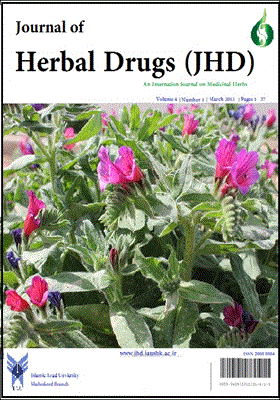کاربرد الیسیتورها برای افزایش تولید متابولیت های ثانویه در سوسپانسیونهای کشت سلول و اندام گیاهی
Subject Areas : Journal of Medicinal Herbs, "J. Med Herb" (Formerly known as Journal of Herbal Drugs or J. Herb Drug)
مریم محمدی فارسانی
1
,
عبدالله قاسمی پیربلوطی
2
![]()
1 - دانشگاه پیام نور تهران شرق، ایران
2 - مرکز پژوهش های گیاهان دارویی و دام پزشکی سنتی، دانشگاه آزاد اسلامی واحد شهرکرد، شهرکرد، ایران
Keywords: الیسیتور, متابولیت ثانویه, کشت سلول گیاهی, مسیرهای سیگنالرسانی,
Abstract :
در زیست فناوری همواره به بررسی مسیرهای جایگزین برای تولید ترکیبات طبیعی توجه میشود. سیستمهای کشت سلول و اندام گیاهی برای تولید متابولیت های ثانویه ای که اهمیت تجاری در صنایع غذایی و دارویی دارند قابل جایگزینی میباشند. با این حال، تقریباً تعداد کمی از محیطهای کشت این ترکیبات را سنتز میکنند و میزان این سنتز و مدت زمانی که صرف میکند قابل مقایسه با استفاده از یک گیاه کامل میباشد. روشهایی شامل تغییر محیط کشت (افزودن مواد مغذی و هورمونی) و شرایط محیطی (تغییرات دما، pH و اسمزی) و همین طور از مواد استخراجی و ترکیبی نیز در این راهبردها استفاده می شده است. امروزه از دستکاری ژنتیکی مسیرهای بیوسنتتیک با استفاده از مهندسی متابولیکی که امروزه برای بهبود تولیدات متابولیت های مورد نیاز تکنیکی قدرتمند شده است استفاده میشود. نتایج مطالعات انجام شده نشان میدهد که هم الیسیتورهای زیستی و هم غیر زیستی سنتز متابولیتهای ثانویه را در محیط کشت سلولهای گیاهی افزایش میدهند.
Bonfante, P. 2009. Symbiotic fungi: principles and practice. vol. 18. Springer Heidelberg Dordrecht London New York. pp 373
Bourgaud, F., Gravot, A., Milesi, S. and Gontier, E. 2001. Production of plant secondary metabolites: a historical perspective. Plant Science, 161: 839-851.
Box, G.E.P. 1945. The exploration and exploitation of response surfaces: some general considerations and examples. Biometrics, 10: 16-60.
Dixon, R.A. 2001. Natural products and plant disease resistance. Nature, 411(6839): 843-847.
Hadimani, S.B., Tanpure, R.P. and Bhat, S.V. 1996. Asymmetric total synthesis of (-) Podophyllotoxin. Tetrahedron Lett, 37: 4791–4794.
Imbert, F. 1998. Discovery of podophyllotoxins. Biochimie, 80: 207-222.
Li, J., Ou-Lee, T.M., Raba, R., Amundson, R.G. and Last, R.L. 1993. Arabidopsis mutants are hypersensitive to UV-B radiation. Plant Cell, 5: 171–179.
Oksman-Caldentey, K. M., and Inze, D., 2004. Plant cell factories in the post-genomic era: new ways to produce designer secondary metabolites. Trends Plant Sci, 9: 433-440.
Patel, H. and Krishnamurthy, R. 2013. Elicitors in Plant Tissue Culture. Pharmacognosy and Phytochemistry, 2: 60-65.
Pichersky, E. and Gang, D.R. 2000. Genetics and biochemistry of secondary metabolites in plants: an evolutionary perspective. Trends in plant science, 5: 439-445.
Rao, R.S. and Ravishankar, G.A. 2002. Plant tissue cultures; chemical factories of secondary metabolites. Biotechnol, 20: 101-153.
Stahelin, H.F. and Wartburg, A.V. 1991. The chemical and biological route from podophyllotoxin glucoside to etoposide. Cancer Res, 51: 5-15.
Vasconsuelo, A. and Boland, R. 2007. Molecular aspects of the early stages of elicitation of secondary metabolites in plants. Plant Sci, 172: 861-875.
Wink, M., Alfermann, A.W., Franke, R., Wetterauer, B., Distl, M., Windhovel, J., Krohn, O., Fuss, E., Garden, H., Mohagheghzaden, A., Wildi, E. and Ripplinger, P. 2005. Sustainable bioproduction of phytochemicals by plant in vitro cultures: anticancer agents. Plant Genetic Resour, 3: 90-100.
Zhao, J., Davis, L.C. and Verpoorte, R. 2005. Elicitor signal transduction leading to production of plant secondary metabolites. Biotechnol Adv, 23: 283-333.
Zhoua, L.G. and Wu, J.U. 2006. Development and application of medicinal plant tissue cultures for production of drugs and herbal medicinals in China. Nat Prod Rep, 23: 789–810.


